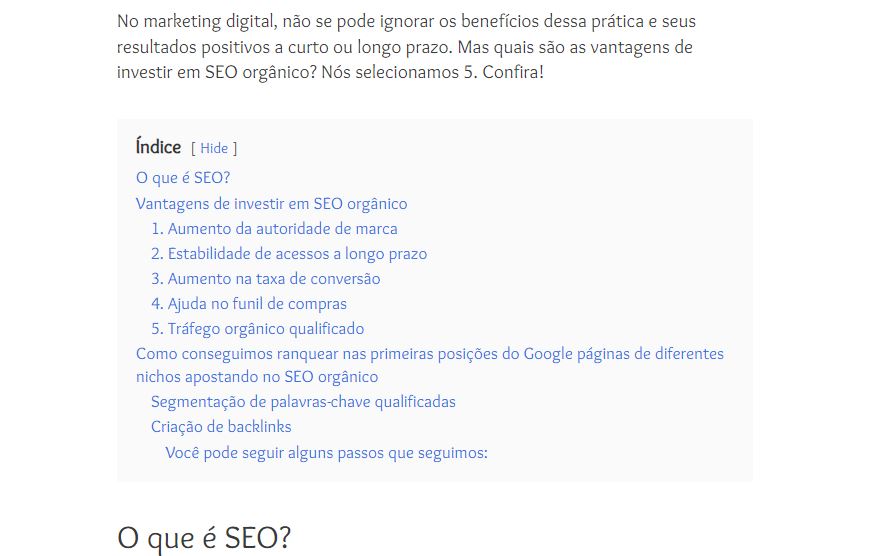
Optimizing a website for search engines is a fundamental strategy to increase access to your content and boost organic traffic. Learn more!
Any website aims to rank well on search engines. This is because the vast majority of visitors arrive at your page through search engines—whether Google or Bing.
Thus, it is easy to understand why website optimization is essential for generating more visits. Additionally, organic traffic and high-quality content create trust and familiarity, key factors that encourage users to keep returning to your site.
Although technical aspects such as design, programming, and accessibility are important, traffic is directly linked to optimization. These are all essential factors in keeping content on the first page of search results.
Learn how to optimize your website for search engines and drive organic search traffic to your content.
Understanding Organic Traffic
In simple terms, organic traffic refers to visitors who reach your content naturally, without paid ads. With the right strategies, your page can rank so well that visits come solely from search engine results.
The main goal is to achieve a high ranking in search listings. Pages that rank higher receive the majority of visits.
That’s why knowing how to apply organic SEO strategies is crucial for optimizing your site. Since there is no advertising investment, traffic will depend on high-quality content and proper planning.
Organic traffic is essential for any business with an online presence. The key takeaway is that most people only click on links that appear on the first page of search results.
Understanding this makes it clear why directing organic search traffic to your content is so important. In fact, the more you use SEO techniques to optimize your site, the greater your chances of ranking well and increasing traffic.
A good ranking provides a competitive advantage, boosts credibility, and increases lead generation and sales conversions.
Benefits of Optimizing Your Website for Search Engines
By now, you already know that website optimization is essential for improving search rankings and boosting business credibility.
Organic traffic strategies improve your position on search engines. This means that when users search for a specific topic, they are more likely to find your content.
Optimizing your website also strengthens the relationship with your audience. The more interaction you generate, the closer the connection with your visitors.
This set of initiatives leads to positive and lasting results over time. However, it is crucial to stay updated on search engine changes.
The largest search engine, Google, frequently updates its algorithms to enhance search results and implement new technologies that improve user experience.

Strategies to Optimize Your Website and Drive Traffic to Your Content
There are several strategies to increase traffic to your content, improve rankings, and boost organic visits. The most important is refining your content with SEO tactics.
Consider the following strategies to optimize your website:
1. Keywords
One of the main pillars of SEO is selecting the right keywords. Search engines match the words users type into their search queries with relevant content. Therefore, choosing keywords that resonate with your audience is essential.
However, using this strategy effectively requires thoughtful integration within your content to provide a seamless user experience.
As algorithms evolve, incorporating new updates and AI advancements, careful planning and strategic keyword placement are more important than ever.
2. Link Building
This method involves creating high-quality external links that point to your site. Just like keywords, link building is a crucial factor for search engine rankings.
Quality backlinks increase your website’s authority, positively impacting its organic positioning.
The key takeaway is that the more authoritative the site linking to your page, the higher your site will rank in search results.
3. Responsive Website
A responsive website ensures users can access it seamlessly from a computer, tablet, or mobile device without distortion. In other words, the design adapts to different screen sizes.
These websites use technology that detects a device’s width and adjusts the content accordingly.
4. Relevant Content
Keywords, link building, and responsive design are ineffective if the content itself is not valuable to users. Content must be tailored to your target audience and meet their needs.
Quality is a crucial factor in organic traffic. High-value content, combined with the right strategies, increases your chances of appearing on the first page of search results.

Do you see how important it is to optimize your website for search engines and drive organic search traffic?
Need help with your strategies? We can help! We are an agency specializing in organic SEO techniques to improve your website’s ranking. Talk to our SEO experts!
Our SEO Content Optimization Strategies That Deliver Results for Our Clients
Our team specializes in content marketing and focuses on implementing effective SEO strategies. We also optimize and update existing content to enhance its performance.
By applying the right techniques, we help ensure your content appears among the top search results on Google. To achieve this, we use several key strategies, such as:
1. Diagnosis
First, we analyze your website’s niche and target audience. We also review existing content to determine the best strategies to apply.
We typically implement multiple content marketing strategies, including:
- Selecting the most relevant primary and secondary keywords to include in the content;
- Updating information using only reliable sources;
- Adding new content that enhances user knowledge;
- Incorporating high-quality internal and external links.
2. Text Structure
If a text is not easily scannable, we restructure it. Users should be able to quickly browse your content and identify whether it answers their questions.
If a visitor lands on your page but finds it unappealing or unclear, they are likely to leave, increasing the bounce rate—a negative metric for your website.
To optimize readability, we include:
- H2 and H3 headings, with no more than 300 words between them;
- Bullet points;
- Images and/or infographics;
- Videos, if necessary;
- Links that enrich the content and provide additional resources.
Additionally, we add a clickable index to help users quickly navigate to the most relevant sections. Here’s an example:
3. Meta Tags
One of our key SEO content optimization techniques is improving the SEO title and meta description. These elements appear in search engine results and play a crucial role in attracting clicks.
Although meta descriptions do not directly influence rankings, they act as CTAs (Calls to Action), encouraging users to click on your site.
Here’s an example of a well-optimized title and meta description:
Above, you can see a screenshot from the Meta SEO Inspector tool, showing the title and meta description of our website. The description is compelling and includes strong keywords, particularly the primary keyword.
Now that you know how to optimize your website for search engines, take advantage of these tips to generate more organic traffic!
Need help? Contact our SEO experts today!

